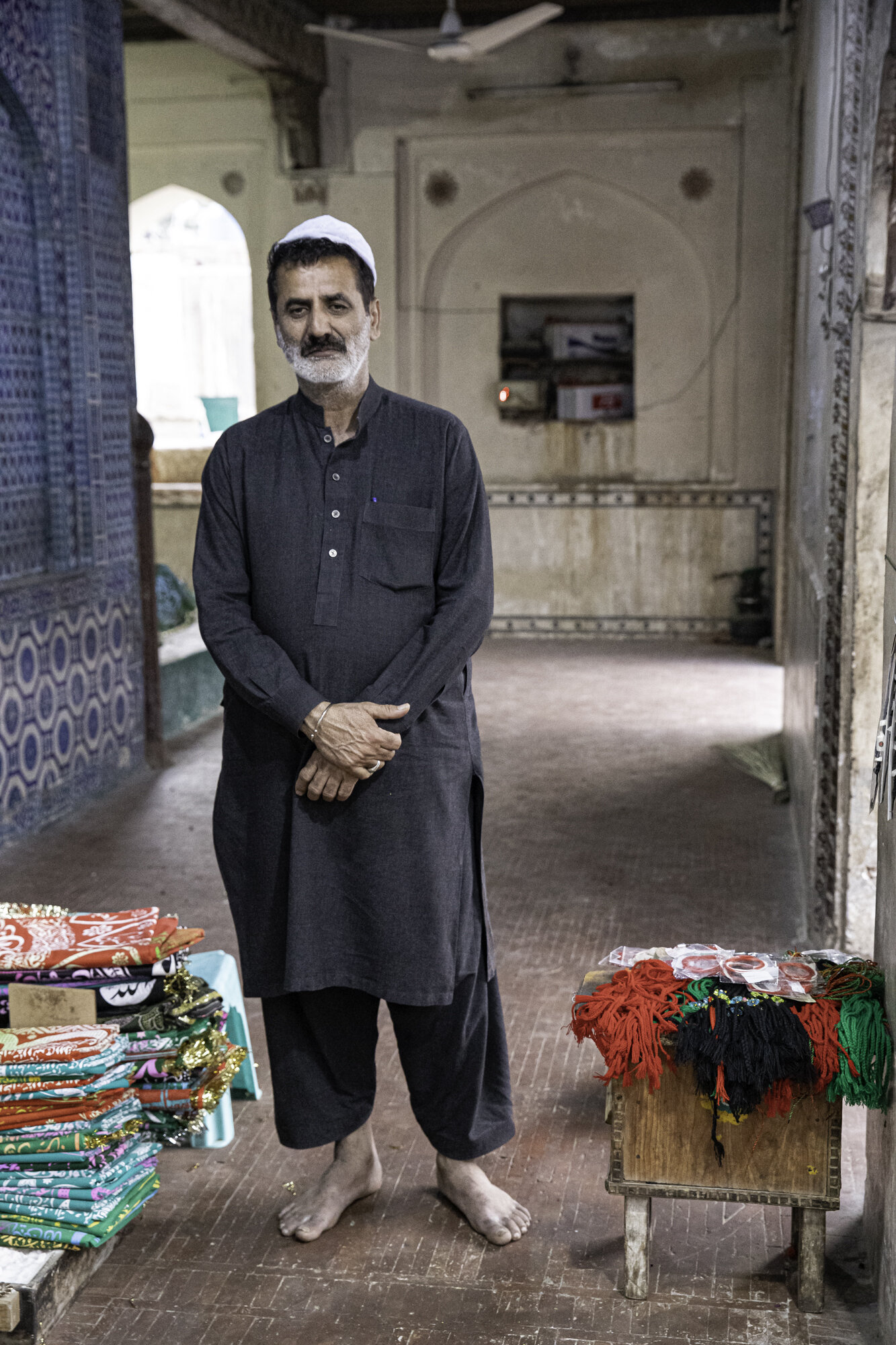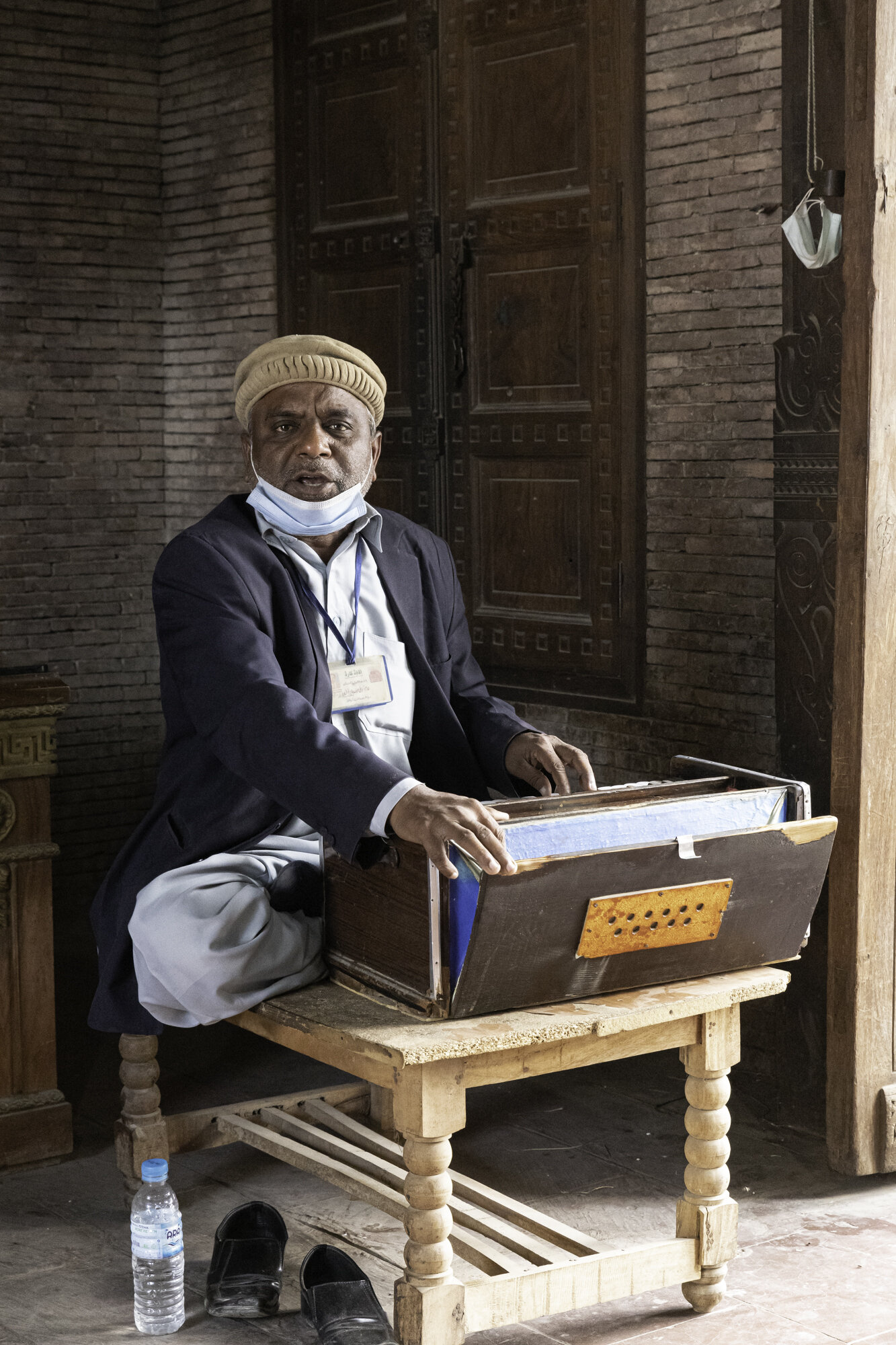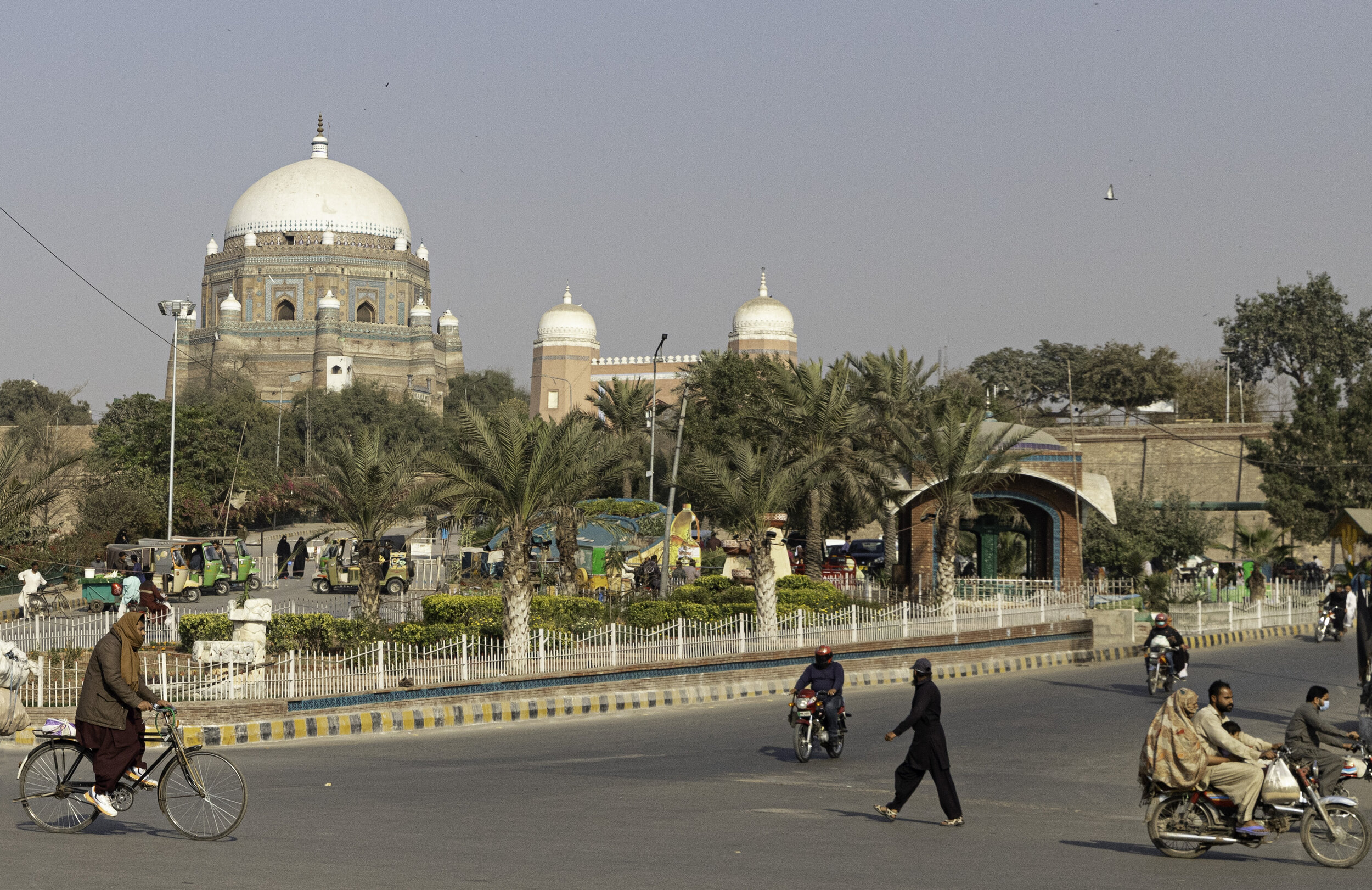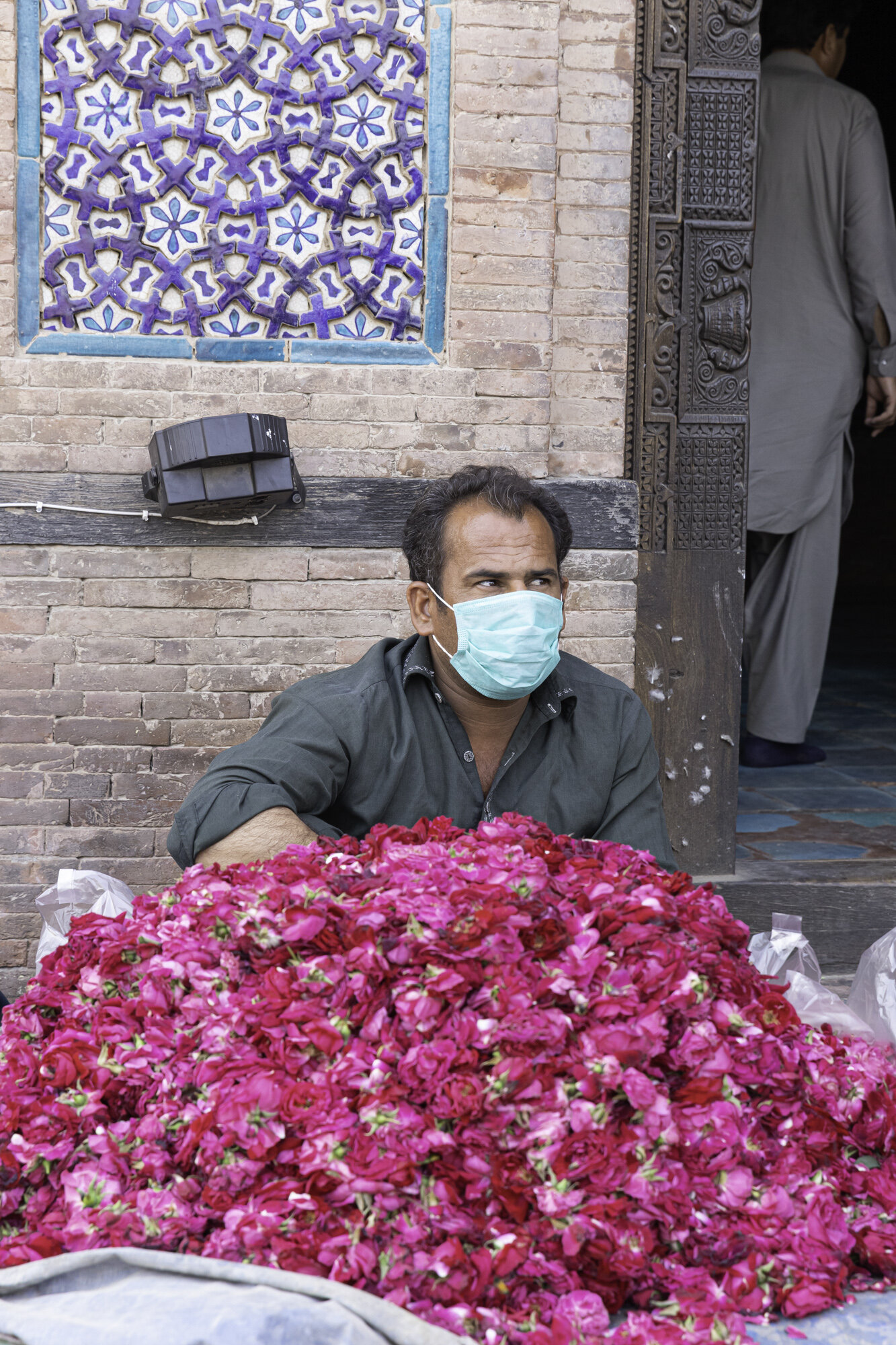Postcards from Pakistan
Postcard from Shah Shams Sabzwari Shrine - a saint, a shrine, a story
We visited Multan in March as the weather was good for travelling, it was considered mild with most days in the low 30 degrees Celsius. Multan experiences some of the most extreme temperatures in the country with very cold winters and long, scorching summers. As Multan sits close to the Cholistan Desert the city also experiences many dust storms. The average temperature in summer sits in the mid 40’s but it has reached into the mid 50’s.
The air had cleared the day we visited the Shah Shams Sabzwari Shrine to reveal a light blue sky with white clouds. The shrine was the least well looked after shrine we visited in Multan. Built in 1329, extensively damaged by fire in 1770 and rebuilt in 1779. It once sat by the side of the Ravi River, but the river has now moved. I am now beginning to recognise the Multani style of architecture for shrines – a square base, topped by an octagonal level, minarets on each corner, finished with a dome, this time the dome was green not white. There were, of course, lots of beautiful Multani glazed tiles. Across the courtyard from the shrine sits a white mosque. Inside and outside of the shrine it is busy with people and stalls selling religious items, souvenirs and traditional Multani wood blocked print cloth.
When I was doing some background reading for this blog, I found a wonderful website called Oriental Architecture (link below). As well as the usual information on building dates and dimensions I came across the most wonderful story about Shah Shams Sabzwari and Bahauddin Zakariya (see my previous blog on his shrine).
The story goes that when Shams arrived Zakariya was not happy as he didn’t like yet another saint arriving in his city. Zakariya sent Shams a cup filled to the top with milk. A not too subtle way of saying the city is full of saints. Shams sent the full cup back with a rose petal on the top as a way of saying his presence wouldn’t disturb Zakariya.
Zakariya wasn’t happy about the cup being returned so ordered the city merchants not to sell anything to Shams. Shams took pity on his disciples who were hungry and caught a pigeon for them to eat (you will have seen from my other blogs how important pigeons are in the city and that there are so many of them). But no merchant would agree to cook the pigeon. Shams took the pigeon and asked the sun to come closer and cook the bird. The sun came closer, the bird was cooked. The sun never moved back to its original position and this explains why Multan is so very hot.
I want to return to Multan to seek out more of its wonderful treasures, but I won’t return in the summer!
https://orientalarchitecture.com/sid/1321/pakistan/multan/shah-shams-sabzwari-tomb
Entrance to the courtyard surrounding the shrine
green dome, blue tiles, red bricks
Entrance to the shrine
Multani blue and white glazed tiles
Ceiling detail
Multani blue and white glazed tiles
Man selling religious items
The mosque inside the courtyard
One of the entrances to the mosque
Postcard from Bahauddin Zakariya Shrine, Multan
We didn’t have to travel far from the shrine of Shah Rukn-e-Alam to get to our next shrine, the shrine of his grandfather, Bahauddin Zakariya. His full name was Sheikh Kabir Sheikhul Salam Bahauddin Zakariya Al-Asadi-Al Hashmi.
Bahauddin Zakariya was born in 1170AD and died in 1262AD. The shrine was built before his death and he paid for the building himself, unusual for the time. Bahauddin Zakariya founded the Suhrawardiyya order of Sufism. This particular branch of Sufism favoured close contacts with society, established trade schools and renounced austerity.
His tomb is definitely not austere. The base is a square, on top of this is an octagon, topped by a white dome with white minarets. The tomb is decorated with the traditional Multani blue and white glazed tiles, detailed woodwork, and Arabic inscriptions.
Bahauddin Zakariya has been reported to have said ‘Our Multan is comparable to Paradise – tread slowly, the angels are paying obeisance here’. You certainly feel awe as you walk around the tomb and you should definitely tread slowly around Multan, an amazing city.
Multani blue and white glazed tiles
The first time I’ve seen a pillar covered in Multani blue and white glazed tiles
Remains of Multani tiles on the outside of the shrine
Inside the shrine
Top of the dome, inside the shrine
Doorway into the shrine
Gateway into the courtyard
We stopped and listened to a man singing and playing an harmonium
Normally the entrance would be filled with people but they were kept waiting as we visited the shrine
Postcard from Shah Rukn-e-Alam (Pillar of the World) Shrine, Multan
As I rounded the corner from the bazaar the tomb of Shah Rukn-e-Alam came into view on top of the mound of an old fort. I can see why it is listed as a possible UNESCO World Heritage Site. It is an imposing three-tiered structure, surrounded by a large courtyard. The first section is an octagon with round towers at each corner, this is topped by another octagon with white tomes, topped by a 15-meter diameter white dome. The building was thoughtfully restored in the 1970’s and uses a mix of red bricks, traditional Multani glazed tiles, and shisham wood.
The tomb was built between 1320 and 1324 by Ghiyath al-Din Tughluq and was thought to have been built for his family. However, the tomb was gifted to the family of Rukn-e-Alam and his remains were moved to the shrine in 1330.
During the Tughluq period Islam spread through the region by large numbers of Sufi teachers. By the early 12th century Multan was regarded as a centre of Sufi learning. Shah Rukn-e-Alam (Pillar of the World) was a Sufi saint. He came from a long line of saints, his grandfather was Bahauddin Zakariya, I will write another blog about Bahauddin Zakariya and his shrine that is situated very close to this one. The Pakistan Foreign Minister, Shah Mehmood Qureshi, is the current custodian of the tomb.
Shah Rukn-e-Alam is still revered today and annually over 100,000 pilgrims from all over South Asia visit the shrine. I can now add myself to that number.
Shah Rukn-e-Alam Shrine seen from the bazaar
Gateway into the shrine
Traditional Multani blue and white glazed tiles
Rose petals for sale outside to scatter over the tomb
Tomb surrounded by 72 graves of his family
Decorative shisham wood panel
Lighting candles outside the shrine
View of the Shrine from the top of the Multan Museum









































